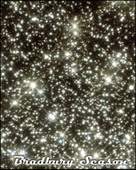It’s the most wonderful time of the year, I think — October, leading up to All Hallow’s Eve. There is something richer about fall after the thin heat of summer; it feels like a time particularly suited to stories.
And, of course, to vampires. Now, sure vampires are overdone. There’s a tiredness to the whole business that is only overcome by sheer force of will. Usually, it requires something new to accomplish this — something like Scott’s scientific rationale and parasite love, or mixing it up with a fantasy vampire-themed restaurant like Cynthia’s Sanguini’s. 
But today, I want to talk classics. I want to talk scary vampires that crawl out of graves and have bad hygiene and menace superstitious villages. Think Nosferatu minus the suit and you’re in the right ballpark.
I leave up to you the order in which you choose to read the following two books, but they are a perfect pairing for Bradbury Season. Both these books return to the roots of the vampire, the things that made them so interesting and scary and potent to begin with, in a fine gothic style.
 The first is Paul Barber’s Vampires, Burial, and Death: Folklore and Reality
The first is Paul Barber’s Vampires, Burial, and Death: Folklore and Reality![]() . This is an absolutely delicious, fairly academic book from Yale University Press. Barber dissects centuries of burial traditions and superstitions and the like surrounding the vampire, while also getting at the larger issues of why the idea of such a creature exists and why it has inspired so many outrageously interesting practices.
. This is an absolutely delicious, fairly academic book from Yale University Press. Barber dissects centuries of burial traditions and superstitions and the like surrounding the vampire, while also getting at the larger issues of why the idea of such a creature exists and why it has inspired so many outrageously interesting practices.
I’ll give you a transitional paragraph picked at random from the chapter "Some Theories of the Vampire" to convince you:
Clearly we must begin by determining whether our informants–who show a remarkable unanimity–are telling us even part of the truth. Do bodies swell, change color, bleed at the lips? People who have exhumed buried bodies know more about such bodies than people who have not done so: the Serbian peasant has an edge on the folklorist. And the forensic pathologist, it would seem, has an edge on both of them and will be our constant companion for the next chapters.
If you can resist a book like this, you and I may be in danger if we’re ever stuck making cocktail conversation.
That covers the academic side, the history and folklore, so how about a new book that takes those original traditions and makes a beautifully successful, wonderfully scary gothic out of them? Marcus Sedgwick‘s My Swordhand is Singing
beautifully successful, wonderfully scary gothic out of them? Marcus Sedgwick‘s My Swordhand is Singing![]() is on the cusp of release here in the U.S., having won the shadow Carnegie last year in England. (Sidenote: Isn’t that the best title you’ve encountered in ages?)
is on the cusp of release here in the U.S., having won the shadow Carnegie last year in England. (Sidenote: Isn’t that the best title you’ve encountered in ages?)
I was skeptical when it showed up in the mail, for the reasons in the paragraph above about vampires =ing tired. But that title. It overpowered me. I’m so glad.
I won’t say much to spoil it, but Sedgwick does a remarkable job conjuring a remote seventeenth century village and the complicated dynamics between a boy and his father, um, vampire-hunting together. The writing is rhythmic and lovely. A taste:
Away, across one of the river’s arms, something watched the hut. It stirred. The figure of shadow moved slowly from cover and then sped like daybreak into the trees.
It’s a spare book, a quick one and oh so satisfying. The perfect read for Bradbury Season.
Check out what my compadres are recommending for their creepy October reads over at Chasing Ray (full list at the bottom of Coll’s post).
